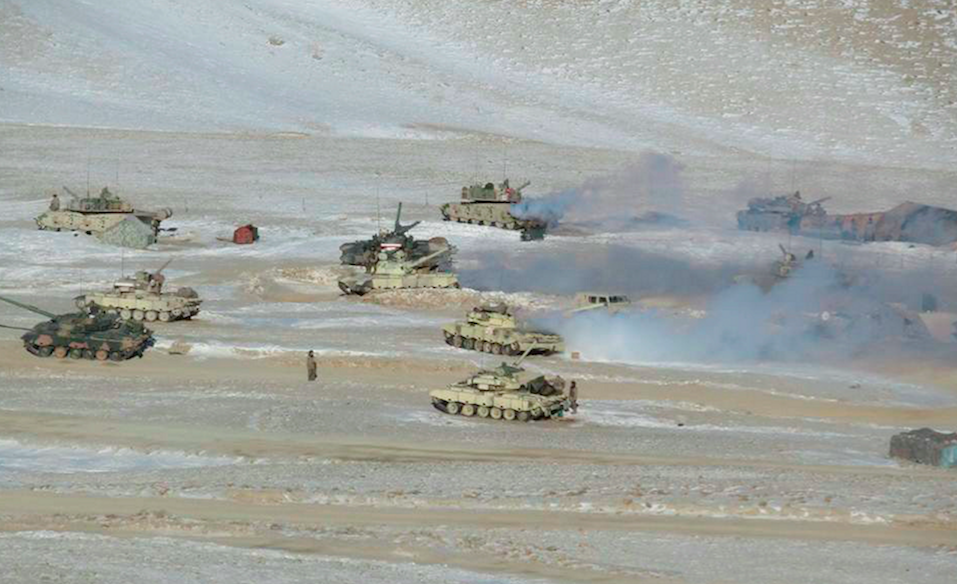Consequently, India now appears to be the aggressor. Worse, it has handed over the Ladakh narrative on a platter to China.Tragically, this has happened at a time when the Indian Army leadership – the lead service in any confrontation with the People’s Liberation Army (PLA) – has failed to understand how to fight the war China is preparing for. Hence, the government needs to be asked why and how such a blunder has been made, especially at a time when India is militarily unprepared. Clearly, those who have advised the government on this matter have no idea about both China and future warfare.
The unravelling of India’s tough-guy posture started with a shocking admission by the minister of state for road transport and highways and former army chief General V.K. Singh, to whom was assigned the ignominious task of writing on the wall.
Speaking to the media in Madurai on February 7, he said: “…none of you come to know how many times we have transgressed as per our perception. We don’t announce it. Chinese media does not cover it… Let me assure you, if China has transgressed 10 times, we must have done it at least 50 times, as per our perception.”
This was in contradiction to the Indian position that it never transgresses. It reinforced the Chinese claim that the actual Line of Actual Control (LAC) was its unilateral 1959 one. Hence, by adhering to the 1993 LAC, the Indian Army was guilty of transgressing Chinese sovereignty.
Losing little time, China, while putting the blame for Ladakh on India, said it would defend its sovereignty at all costs. To recall, China’s President Xi Jinping, since assuming power in November 2012, has repeatedly said that not an inch of its territory would be given up. To take the Chinese argument further, nothing stops China from voicing the idea of reunification of the state of Arunachal Pradesh, which it calls South Tibet, with the mainland.

An Indian Army convoy moves along a highway leading to Ladakh, at Gagangeer in Kashmir’s Ganderbal district June 18, 2020. Photo: Reuters/Danish Ismail
Perhaps, one shouldn’t be too harsh on V.K. Singh for apportioning the blame of the Ladakh crisis on the army he once commanded. Through January 2021, numerous media reports had unnerved the Modi government. Showing commercial satellite imagery, these reports spoke of massive PLA war preparedness in Tibet opposite Arunachal Pradesh.
With the possibility of a two-front war staring it in the face, the Modi government clearly panicked. The military thinking, conveyed to the government, was that while the army (military) could fight a two-front war (fighting the primary front while holding the second one), China should not be the primary front because then Pakistan would be certain to open the second front. In Indian thinking, the opposite wouldn’t happen.
Consequently, such was the haste to deescalate, that the Modi government also gave up the only tactical bargaining chip it had in Ladakh – the Kailash range in south Pangong which overlooks PLA’s Moldo garrison and was captured by the Indian Army in a daring night operation. The September 10 Moscow agreement between foreign minister S. Jaishankar and Chinese state councillor Wang Yi had been held up for five months because of this niggling point. The PLA was insistent that the Indian Army vacate the heights on the Kailash range. With the Pangong disengagement underway, defence minister Rajnath Singh told Parliament on February 10 that other friction areas like Hot Springs, Gogra, Demchok, and especially Depsang would be taken up within 48 hours.
Even as the Indian government was walking on eggshells, Wang Yi decided to put out in the public domain the Chinese perspective on the Ladakh face-off, as well as the future of the bilateral relationship. The Chinese readout of the telephonic conversation between Jaishankar and Wang Yi (at Jaishankar’s initiative) claimed that India was responsible for aggression in Ladakh and that it had strayed from the path of friendly ties and needed to come back on track. This was an unambiguous reference to the Wuhan understanding reached between Prime Minister Narendra Modi and Xi at the first informal summit in 2018 where both sides had committed to cooperate and not be rivals.
Of course, no reference was made to the PLA’s massive build-up and the threat to Arunachal Pradesh dangling over India. In order to ensure that the Modi government did not wander off the path again, it was decided to have a hotline between the two foreign ministers. Interestingly, India, for a decade, had been unsuccessfully asking China to have a hotline between the two armies for quick resolution of border face-offs.
Under the Wuhan understanding there is plenty that China needs India to deliver: Normalise bilateral trade to pre-Ladakh levels; not be a party to the militarisation of Quadrilateral Dialogue mechanism (between US, Japan, Australia and India) and the US-led Indo Pacific strategy to contain China; not use its soft power (comprising continuity and traditional ties) to influence (against China) smaller nations in South Asia which have already signed-up for the Belt and Road Initiative; and to work with China under the agreed China-India-Plus one (smaller nation) model for regional prosperity.
Pakistan angle
If this was not enough, China also played a crucial, behind the scene role, in the February 25 announcement of a sudden ceasefire on the Line of Control by the director generals of military operations of India and Pakistan. During the second informal summit between Prime Minister Narendra Modi and Chinese supremo Xi Jinping in October 2019 in Chennai, Xi had spoken at length on the need for trilateral ties between India, Pakistan, and China for peace, trade and connectivity in the region. It was reported in The Hindu of October 17, 2019 by its Beijing reporter, attributing this disclosure to Wang Yi. Since it was in the immediate aftermath of August 5, 2019, Modi ignored it.
To remove doubts on the ceasefire announcement by military officers of the two sides, Pakistani Prime Minister Imran Khan tweeted the following day that it was now for India to create an enabling environment for further progress for normalisation of relations. Pakistan had downgraded diplomatic ties with India following the reading down of Article 370 and the scrapping of 35A from Jammu and Kashmir. It now wants India to reverse that: Restore Articles 370 and 35A and revert to the pre-August 5, 2019 constitutional status of Jammu and Kashmir. Basically, convert the union territories of J&K and Ladakh back into the state of J&K.
While Pakistan has the full support of China for its demands made on India, it would be unwise to underwrite Pakistan’s self-confidence which has come from its risen geopolitical status. Pakistan, under its first hybrid government of Imran Khan and army chief, General Qamar Bajwa has successfully transformed itself into a self-assured nation eager to see beyond India – its perceived existential threat. Being the flagship of China’s 2013 BRI through the China Pakistan Economic Corridor, and the pivot of the 2015 Digital Silk Road (to leapfrog into the fourth industrial revolution of artificial intelligence), Pakistan’s narrative today is about trade, connectivity, and peace. How convincing this peace narrative is can be assessed by Pakistan’s recent multi-nation naval exercise, Aman-21, where the navies of all three geostrategic players (the US, Russia and China) participated.

File photo of Indian soldiers on the Line of Control. Photo: PTI
Moreover, post-August 5, 2019, events in J&K have got Pakistan and China, already in a strategic partnership, into a tighter embrace. Pakistan consults China on policy matters, and the two have developed the kind of interoperability (i.e. the ability to fight together against a common enemy) which would dwarf that between North Atlantic Treaty Organization (NATO) allies.
While China and Pakistan have little intention of going to war with India now, should war happen in the future, the PLA and Pakistan military would be in it together with defined missions. The reality is that the Indian military’s two-front war threat has been replaced by a one-front reinforced war threat. The PLA, in a double tasking role, would fight in the eastern and central sectors (Sikkim and Arunachal Pradesh), and support the Pakistan military with its awesome non-kinetic and kinetic capabilities in the western sector of Ladakh.
For the present, China has more than achieved its objectives in Ladakh. Not only does it now occupy territory upto its 1959 claim line without fighting but it also got the Indian government to admit that India had repeatedly violated Chinese sovereignty, by clinging to the 1993 line, which did not exist in the Chinese narrative.
China knows that the Modi government has sought temporary reprieve and has no intentions of desired cooperation with China, especially when post Ladakh, it is unable to arrive at a geopolitical equilibrium with it. Modi would likely stray away from the Wuhan understanding soon in the hope that the Indian military would get a breather for war preparedness which has already begun. There are reports of army formations being permanently moved from the Pakistan front to the Chinese front, and the army is gearing up for round the year taskings on the LAC and the air force is strengthening its capabilities against the PLA Air Force (PLAAF). The paramilitary forces, as the first line of defence, are also being reinforced and rationalised.
The problem, however, is that the army and the air force are bracing themselves for the wrong war against the PLA. This is apparent from the remarks made by the army chief, General M.M. Naravane on February 24 at the webinar organised by the Delhi-based Vivekanand International Foundation. The PLA has at least eight ‘systems destruction’ and algorithm war-fighting strengths, two of which are its capability to fight exceptionally in the virtual domains of war, and its flexible and intelligent software systems connectivity.
The PLA considers cyberspace and electromagnetic space as one continuum and understands that without supremacy, if not dominance, in these virtual spaces, a conventional war would be decisively lost before it is joined. Cyber, electronic, and space war domains reside in this virtual space with the capability to blind, disable, disorient, and destroy communications at all levels of war.
To put it bluntly, in the 1962 war, Indian soldiers fought valiantly, but were let down by their command which took to heel. In war with the PLA, bereft of communications, interaction between command and rank and file would get snapped, leading to uncertainty and chaos. The Indian military, focused on physical war domains, has failed to understand the operational importance of virtual war fighting.
According to General Naravane, Multi Domain Operations are the future of war for which the army is preparing. Globally, however, this decade-old warfighting strategy has been replaced by Joint Multi Domain Operations. There is a huge difference between the two.
The US military worries that the PLA’s strength in software systems would allow it quicker information flow between the six war domains (space, cyber, electronic, land, air, and sea) in Joint Multi Domain Operations, allowing it to close the kill chain (data-decision making-action loop) faster than it could do. Given this, the US military, while fighting the PLA, could lose the war of cognition (military decision making), leading to defeat.
An analogy would help understand the importance of software systems where the Indian Army (military) has paid scant attention. For example, the value of a smartphone is not its hardware but the software system which supports applications. This is why notifications are regularly given to users to update software operating systems in their smartphones. Today, with 4G networks, smartphones provide cloud facilities. With 5G wireless telecommunications, smartphones would transform into a virtual internet in-hand. All this is true in algorithm war where the PLA is a global leader.
In General Naravane’s view, tanks, ships, and aircraft which were the fighting icons of the 20th century would be rendered less significant in war. This is not correct. They would remain significant as unmanned and intelligent (autonomous) weapon platforms. Inspired by the swarm drone warfare seen in the Armenia-Azerbaijan war, the army chief said these would be the game-changers in future war. According to him, by demonstrating a swarm of 75 drones on Army Day on January 15, a powerful message was sent to India’s adversaries (China and Pakistan). The reality is that in a war with the PLA, swarm drones, if used at all, would be a side show.
There is a reason why I have quoted extensively from General Naravane’s talk. By exposing the Indian Army’s lack of understanding of new war with disruptive technologies, the army chief has unwittingly harmed the Indian military posture. The PLA would now be even more aggressive and experimental with its unmanned systems in a possible future war with India. The lessons learnt against India with first mover advantage would help the PLA in better preparing against its main adversary, the US military.
Even though no catch-up is possible with China, India, by understanding future war correctly, can at least it can start preparing for the right war. The current military reforms enunciated by chief of defence staff General Bipin Rawat are only harming the military more. They must be stopped forthwith.
Having got its way in Ladakh by forcing India to accept the 1959 LAC – something that China had not managed to do in 60 years – Beijing will not ease its pressure on India. Past-masters of conflict and cooperation, China will continue with its military coercion all along what is now a reinforced one-front from west to east, even as it pressures India to normalise ties. India has only itself to blame for its increasingly limited options.
































